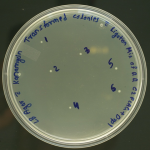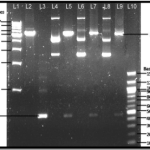1. Take 1.5 ml of overnight grown culture into a sterile Eppendorf tube.
2. Centrifuge the cells at 12,000 rpm for 2 minutes at 4 °C. [Note: You can repeat Step 1 if you have a lower harvest]
3. After harvesting, discard the supernatant and resuspend the pellets in 100 µl of Solution I. [Note: Resuspend thoroughly such that no clumps remain]
4. Then, add 200 µl of Solution II and mix the tubes by inversion. [Note: Look for the mucoid thread when opening the lid slowly]
5. Add 150 µl of Solution III to the tube and mix by rotating the tubes.
6. Incubate the tubes on ice for 5 minutes.
7. Following this, centrifuge the tubes at 12,000 rpm for 5 minutes.
8. Then, transfer the supernatant to the new tube. [Note: You might need to repeat Step 7 depending upon the amount of debris that floats at the surface]
9. Add an equal volume of isopropanol or twice volume of ethanol to the tubes and vortex. [Note: Vortex thoroughly for better precipitation]
10. After vortexing, centrifuge the tubes at 12,000 rpm for 10 minutes.
11. Discard the supernatant and wash the pellet with 70 % ethanol. [Note: Invert the tube up and down for 2 minutes]
12. Centrifuge the tubes at 12,000 rpm for 5 minutes and discard the supernatant. [Note: Be careful while draining off the liquid as the pellet which is now loose could also flow away with the liquid. Also, remove residual ethanol at the bottom of the tube with the help of a pipette for faster drying]
13. Then, leave the tubes for drying after which dissolve the pellet in TE buffer. [Note: Failure to dry the tubes can result in the floatation of DNA sample during Agarose gel electrophoresis as well as inhibition of enzymes during further downstream processes].

Composition:
Alkaline Lysis Solution I: [Needs to be autoclaved for sterilization]
50 mM Glucose
25 mM Tris-HCl (pH 8.0)
10 mM EDTA (pH 8.0)
Alkaline Lysis Solution II: [Needs to be freshly prepared before the experiment]
0.2N NaOH
1 % Sodium Dodecyl Sulphate
Alkaline Lysis Solution III: [For 100 ml]
5 M Potassium Acetate: 60 ml
Glacial Acetic Acid: 11.5 ml
Deionized water: 28.5 ml
Reference:
Sambrook, J., Fritsch, E.F., dan Maniatis, T. 1989. Molecular Cloning A Laboratory Manual 2nd edition. New York : Cold Spring Harbor Laboratory Press.






Pingback: Underlying Principle of Different Solutions Used for Isolation of Plasmid from Bacteria by Alkaline Lysis Method - Aneknowledge.com
Pingback: Comparison between Horizontal Gene Transfer Mechanisms in Bacteria: Transformation, Conjugation and Transduction - Aneknowledge.com